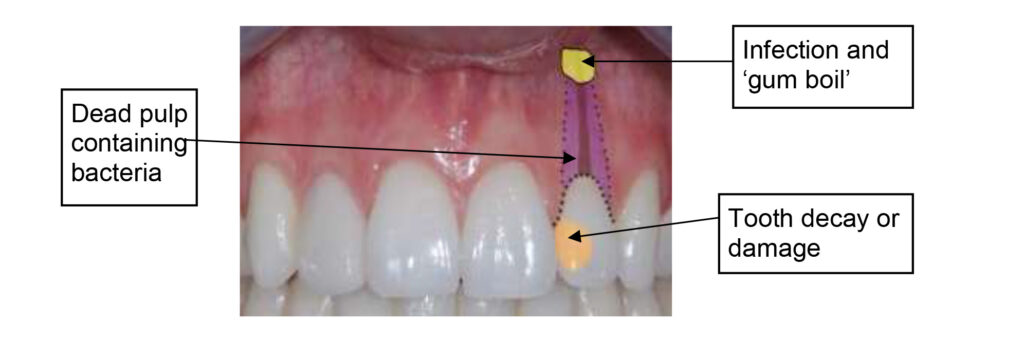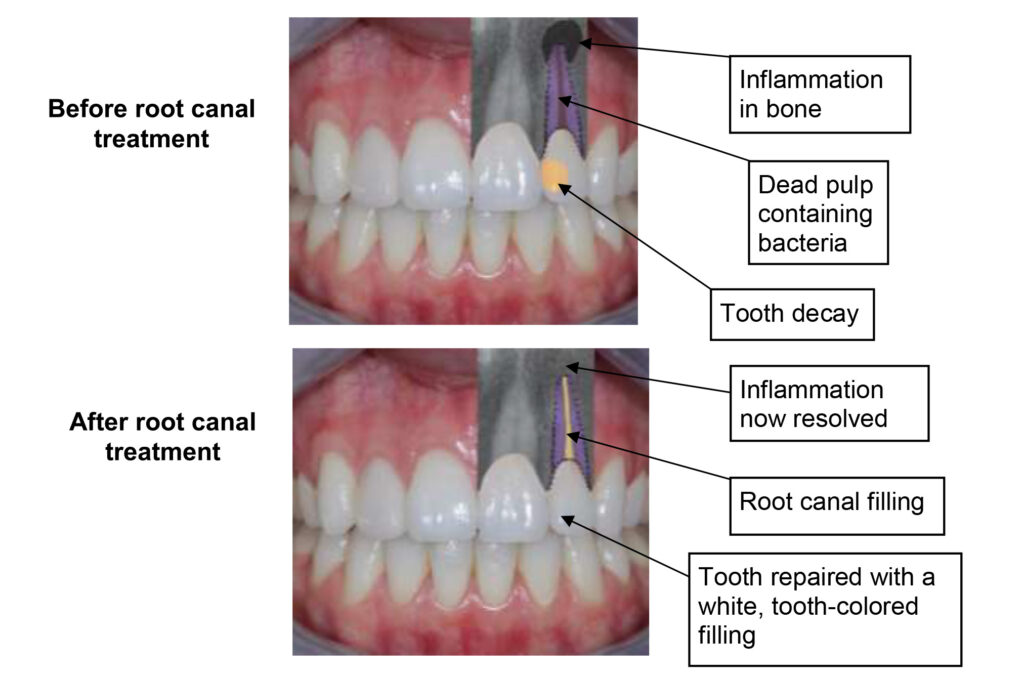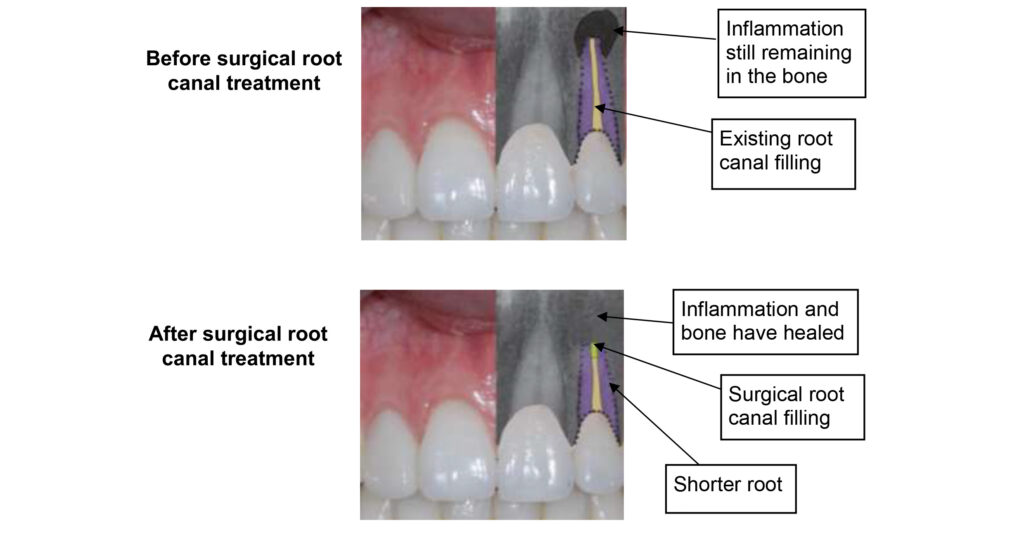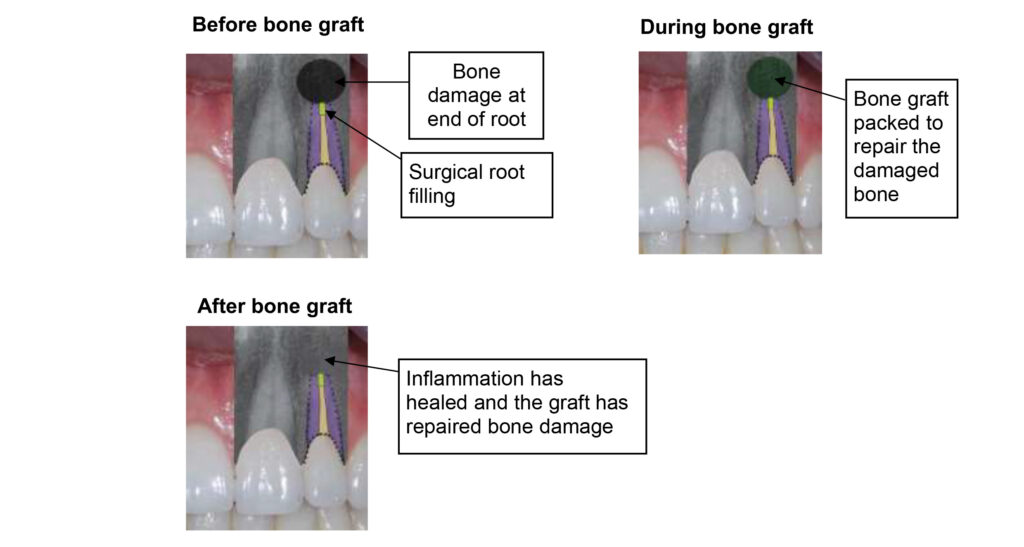A patient’s guide to surgical dental procedures to treat teeth with infected and injured roots.
This booklet provides information about surgical dental procedures which can be undertaken when the roots of teeth are infected or injured.
We usually discuss surgical treatment options with you after non-surgical root canal treatment has been tried.
Healthy teeth and gums
Healthy teeth are living structures which have a crown and a root. The crown is the white part, which is visible in the mouth and the root is the part underneath the gum surrounded by bone.

Each root has a narrow tube inside it which is called a ‘root canal’. This canal
contains the nerve and blood supply to the tooth which is also called the ‘dental
pulp’.
What happens when teeth get injured?
Teeth can get injured in a number of ways. The most common ways are from tooth decay, accidents (trauma), dental treatment and from surface damage by ‘wear and tear’.

When a tooth is injured the blood supply inside the root is damaged and the dental pulp can die. Bacteria can then enter the root canal and cause problems like painful abscesses, gum boils and cysts. The body cannot resolve these problems and in order to try to save the tooth ‘root canal treatment’ (which is also called ‘endodontic treatment’) is necessary.
What is root canal treatment?
Root canal treatment is the process of removing a dead pulp and bacteria from inside the root of a tooth. It is highly effective and a way of resolving pain and infection associated with a badly injured tooth. The treatment aims to save the tooth and avoid the need for the tooth to be removed (extraction).

Root canal treatment is initially carried out in a ‘non-surgical’ way. The dentist makes a small hole in the biting surface or ‘back’ surface of the tooth. The root canal is shaped, cleaned and disinfected. A root filling material is then sealed into the space to prevent infection from returning, this is called a ‘root canal filling’.
It is also important to treat any other decay, holes or injury to the tooth that may affect its survival. Sometimes a post made from metal or glass fibre material is inserted into the canal. This can help the dentist to fix the tooth or crown.
For extra strength and protection, a metal or ceramic ‘cap’ or artificial ‘crown’ can be placed on top of the tooth. Strengthening the tooth reduces the chances of it fracturing and from problems returning.
What is surgical root canal treatment?
Pain or infection can sometimes remain after non-surgical root canal treatment has been undertaken. In these situations the options are to either re-do the non-surgical treatment, or to undertake ‘surgical root canal treatment’.
Surgical root canal treatment involves lifting back the gum tissue around the injured tooth to expose the end of the root. Infection and damaged bone are cleaned away.
A few millimeters of the end of the root are removed to allow for further cleaning inside the root. A small filling is sealed in the end of the root before the gum is repositioned with fine stitches.

Reasons for considering surgical endodontic treatment include:
- When non-surgical treatment has not worked
- When it is not possible to access a root for non-surgical treatment because of excessive narrowing of the root canal, or due to the presence of an obstruction such as a post, or a broken instrument from previous treatment
- When it is suspected there is a cyst or other problems in the bone
- To avoid removing or damaging a well-fitting ‘cap’ or artificial crown
- To remove excessive filling material that may have extended too far through the end of the root.
What is a bone graft?
During surgical treatment, after removal of the infection or cyst there can be an area of bone damage. On some occasions a bone graft procedure can be undertaken to fill the hole and repair the damage that has been caused by infection and inflammation.
After a bone graft has been placed, a thin barrier or ‘membrane’ may be needed. The membrane can be a dissolving on non-dissolving barrier which keeps the graft in place during the healing process. If a non-dissolving membrane is placed a second surgical procedure may be needed to remove it.
There are a variety of different types of bone graft and membranes that could be used and your surgeon or dentist will discuss the most appropriate product and technique for you.

Other problems that can be treated surgically?
Occasionally problems can occur on the sides of roots as a result of perforation. A hole can be created during dental treatment, or as a result of dental disease.
Perforations can become infected in the same way as root canals. Sometimes, surgery is the only way to clean the area and provide a filling to repair the perforation.
What to expect during the procedure
- Before treatment we will have a full discussion with you about the benefits
and risks of the recommended surgical procedure. We will give you time to
ask questions and then ask you to give your consent to treatment. - Your surgical appointment time will typically be an hour and a half to two
hours. - The procedure is carried out as a small operation. Sterile drapes are used
and the area around the tooth is disinfected. - The area will be fully ‘numbed’ with normal dental local anaesthetic injections. This
is usually sufficient to ensure that there is no pain or discomfort. If you wish,
we can offer you dental sedation to reduce any anxiety and worry. You will
need to be assessed on a separate occasion for sedation treatment. - Once the gum is numb, we make small cuts in it and gently lift it back to
expose the root end. There will be some vibration and water spray as the
root is cleaned, reduced in length and filled. - On some occasions a bone graft and membrane will be placed into the area
that has been damaged. This treatment option will be discussed before your
procedure so you are aware of what is involved. - The gum will be repositioned with fine stitches and if necessary a dressing
over the gum may be used - After the procedure you will be given advice and instructions to follow to
ensure the best healing and manage any pain or swelling. Antibiotics will not
routinely be prescribed - Over the next few days the area will start to heal. You will be reviewed to
remove stiches, and monitor healing.
What to expect after surgery
After the procedure you will be given specific advice on the best ways to care for your mouth. It is usual to expect some symptoms after dental surgery to your mouth.
Please note:
- It is normal for blood to seep from the site for a few hours
- Pain relief is recommended for a few days
- The area may swell and bruise
- You will not routinely be given antibiotics, but on some occasions they may be needed if there are any signs of infection
- A soft diet will be advised for a few days and it is best to avoid eating in the treated area
- We advise that you use an antiseptic mouthwash during the healing period as tooth brushing in the area of surgery may disturb the stitches.
- You should avoid strenuous exercise and work until advised it is safe to do so by your surgeon or dentist
- Stitches and wound dressings can be dissolvable or non-dissolvable. Non-dissolving stitches are usually removed after one to two weeks.
- During the first three months after surgery your gum and tooth should get healthier and stronger. Review appointments and x-rays may be necessary to monitor healing
- The gums may shrink slightly after surgery, and expose the edges of crowns or small areas of root. These areas may be sensitive to hot and cold. Special desensitizing toothpastes may be helpful
- If a ‘cap’ or artificial crown is planned for the tooth, this can normally be provided after the gum has fully healed, when there are no signs of infection and when there is evidence of bone healing.
Please note it is not always possible to undertake surgical root canal treatment for injured teeth. When surgery is possible, it can never be guaranteed that the problems will be completely resolved.
Sometimes, dental extraction may be necessary even after surgical root canal treatment.
For further information
Contact details
If you have any concerns or questions you can contact the Newcastle Restorative Department during working hours Monday to Friday (9am -5pm) on 0191 282 5130.
PALS (Patient Advice and Liaison Service) for help, advice and information about NHS services. You can contact them on freephone 0800 032 02 02, e-mail [email protected] or text to 01670511098.
Useful websites
If you would like further information about health conditions and treatment options, you may wish to have a look at the NHS website at www.nhs.uk
Useful patient information can be viewed on the British Endodontic Society website www.britishendodonticsociety.org.uk
If you would like to find accessibility information for our hospitals, please visit
www.disabledgo.com